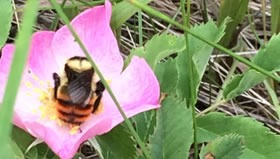Agriculture and Agri-Food Canada (AAFC) is working to get the buzz on bees by better understanding what types of habitats keep them happy so they’ll stick around to pollinate crops.
Pollinators thrive in field boundaries
Field boundaries are the areas such as ditches, fence lines, and road allowances that surround cropped land. As farmland is consolidated into bigger fields, the centres of cropped areas move further and further from these margins – which are home to pollinators, such as bees and other insects. Pollinators provide many benefits to their ecosystems, and with a third of human food supply relying directly on insect pollination, keeping these insects happy is key.
Native species are much more efficient pollinators than their domesticated honey bee cousins, so it is important we understand and maintain the ecosystems they need to thrive. There are over 970 different bee species native to Canada alone (if it helps you to remember, that’s about the same number of months as the average human life in Canada – which is something to think about in its own right …) and most of these (about 90 percent) are solitary (i.e., do not live in colonies). Melanie Dubois, a scientist from AAFC’s Brandon Research and Development Centre, and her team are studying ways to mitigate the effects of reduced habitat on native bees.
Bees need food from spring until fall, but domesticated crops like canola only flower for about four weeks in the summer, so alternative sources are needed. Moreover, most native bees lay their eggs in the ground or other cavities like dead vegetation and wood, and therefore are reliant on untended and wild areas. Through plot studies, Dubois’ team is learning how to recreate native bees’ preferred habitats in the boundaries surrounding agricultural fields. The team is focussed on planting perennial native flowering plants that will serve as a food source from spring to fall, but not interfere with bees’ appetites for pollinator-dependent crops like canola. If the plot studies are successful, then a wider application of bee habitat installations in agricultural field boundaries should sustain or even increase overall crop pollination.
As part of the study, Dubois’ team will conduct habitat assessments and sample bee populations in field boundaries adjacent to canola crops. Using brightly coloured plastic cups filled with a liquid mixture, the team will trap bees at regular intervals throughout the flowering season. During this time, they’ll also complete a habitat assessment, which will include an inventory of vegetation types, farm management practices, and the size and distribution of food and nesting locations within a one kilometre radius of each trapping site.
The project’s main objective is to develop practices that will help farmers and landowners assess, improve, and recreate field boundary habitats that foster pollinator well-being, and ultimately sustain or improve crop production.
“Most of these native bees don’t fly more than a kilometre from their nesting sites, so when fields that rely on pollinators – canola for example – get larger and larger, we have to consider if the flowering plants in the centre of these massive fields are being pollinated, and how we could improve this system.”
~ Melanie Dubois, Senior Riparian and Biodiversity Biologist, Agriculture and Agri-Food Canada
Facts
• Field boundaries provide habitat for native insects that pollinate crops, as well as many other benefits to native ecosystems.
• Researchers at the Brandon Research and Development Centre in Manitoba are working to determine how farmers can better provide habitat for the native bees that are needed to pollinate their crops.
Photo: A native bumblebee harvests pollen and nectar from flowers such as the wild rose.
Thank you to Agriculture and Agri-Food Canada for submitting this article and photo.
